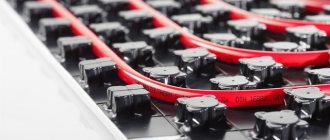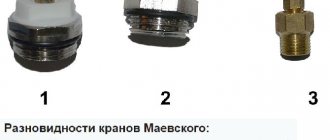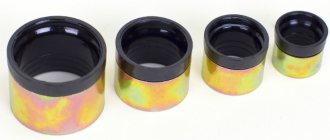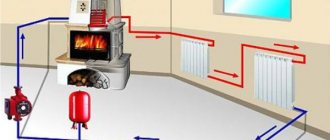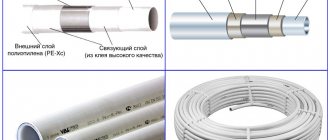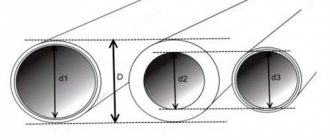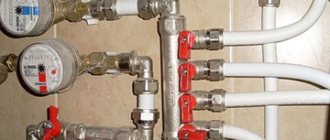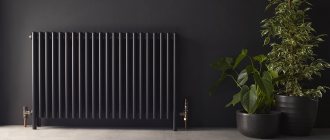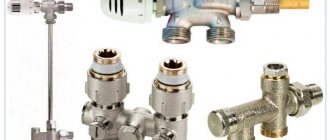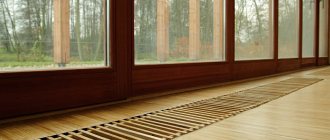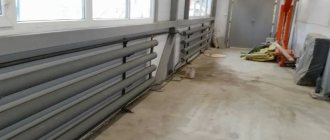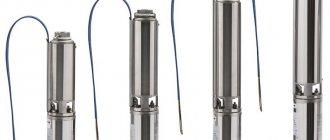In the modern construction market, products for installing utility lines are presented in a wide range. Let's look at what it means to attach a pipe to a wall. Let's get acquainted with the methods of fixing channels, the rules that must be taken into account during installation work. Read to the end and you will find out when and which fasteners are best to choose for risers, underfloor heating systems or hot and cold water supply.
Special fasteners for parallel fixation of pipes Source select.ru
Briefly about the norms and requirements
The installation of utilities for water supply from thermoplastic pressure pipes is carried out taking into account the requirements prescribed by GOST 52134 of 2003. Here we consider the technical conditions for fasteners, fittings, connecting parts and tubular products made of polypropylene, polyethylene, PVC and similar connections.
Another regulatory document is SP 40-101 of 1996. Here are the rules for the design and installation of cold and hot water supply systems made from polypropylene products. These are recommendations for building codes that were drawn up in the period 1980-1985.
The preparation of design documentation and installation work on the installation of steel communications are regulated by GOST 32569 of 2016. Maintenance of large and industrial facilities is carried out under the guidance of the current GOST 14202 of 1969. Here we consider networks for transporting various types of liquids, gases and, less commonly, dry mixtures.
Laying communications in channels ↑
To make it possible to cover the sewer with decor, grooves are punched into the walls. Inside them, the pipelines are secured using the technology described above using clamps. It should be taken into account that there should be no interference with the linear expansion of the collectors.
In the grooves, the drain should also be secured with clamps
Grooving is quite a troublesome task, but with this installation method, the fastening of communications is more reliable. In this case, the pipes are held not only by fasteners, but also by the edges of the groove in the wall.
Criterias of choice
Fasteners may have different composition, configuration, and shape.
Variety of metal clamps Source grodno.in
They are designed to solve various problems. There is also a difference in the installation methods. Let's consider what you need to know to select fixing elements.
Material
Conventionally, pipe fastening to the wall can be divided into two groups: plastic and metal. The fasteners can also be equipped with plastic spacers. As a rule, these are rubber or alternative analogues.
For the production of plastic fasteners, PVC, styrene, propylene, analogues and their modifications are used. The finished product is characterized by the following positive properties:
- can be used for almost any type of engineering system;
- It weighs little, so it does not put a load on supporting structures;
- exhibits resistance to biological, corrosive and chemical influences, to changes in temperature and humidity;
- can maintain a given shape in the form of almost any type of pipe fastener;
- As a rule, it lasts as long as the pipeline itself.
Plastic plumbing clamp Source ozone.ru
The disadvantages come down to strength characteristics. The solution in this case is metal fasteners. It is characterized by:
- Mechanical strength. The main part of the products is made of high-strength steel with increased resistance to environmental operating conditions.
- Versatility. Fastenings are used for fixing plastic and metal pipes to the wall of any type of utility lines.
- A wide range of. It is permissible to manufacture any fasteners here. Manufacturers are also expanding their choice by using various alloys: stainless or galvanized steel, brass and others.
- Durability. Quality products serve no less than communications.
- Maintainability. Most products consist of several elements that can be replaced if necessary. Some samples can be restored if deformed.
Users highlight fewer disadvantages.
Metal wall bracket Source teploten.ru
In particular:
- greater weight compared to fasteners for polypropylene plastic pipes, which may affect the overall load of the system on supporting structures;
- inertness to corrosion, chemical reagents, and humidity changes often turns out to be worse than stated;
- Continuous maintenance is required for tightening, updating the protective coating, and less often, repairs.
Also, the disadvantages include a higher cost than polymer analogues. However, this is justified by the durability and reliability of the clamps. A metal pipe mount to the wall is often indispensable.
By installation method
Depending on the type of engineering communication, the requirements for fastening channels differ. There are only 2 methods: rigid fixation or free. The second option is otherwise called the floating method.
Reliable adhesion of fasteners to pipeline walls is achieved in the case of three types of systems:
- hot and cold water supply;
- heating main;
- sewerage
Free fastening of the air duct Source 1001krep.ru
The purpose of rigid fixation is to prevent the movement of communications during operation. The blocking also prevents any displacement of the mains during size changes due to temperature changes inside and outside the network.
The floating technique involves creating a small gap between the walls of the clamps and the pipeline. The free space allows the channel to move in width and allows for quick replacement of a section or its dismantling.
Another installation method involves installing the pipe away from the surface of the wall or ceiling. For this, brackets or crimp clamps with a metal rod can be used.
The choice of methodology is carried out taking into account the temperature conditions of operation of communications. Thus, inside a heated room, the thermal expansion of the pipeline is insignificant, so a rigid fixation device is allowed. Temperature changes are observed in the basement, outbuildings, and outside the building. Here it is necessary to leave space for the movement of channels.
Installation of pipes in an unheated room Source 1001krep.ru
Pipelines are fastened according to the rules at specific points. These include all node connections: fitting, rotary, branching. The requirements for a straight channel are also met (the distance between fasteners is determined by the direction, weight of the line, type of system).
If you plan to lay communications inside a wall, floor or ceiling structure, then the coefficient of thermal expansion of the pipe is not taken into account. Here fasteners are practically not used. An exception is the underfloor heating system, the base in the form of thermal insulation material.
By constructive decision
Pipeline fixation is carried out in three main ways. Some channels just need to be supported. To do this, use metal fasteners for the pipe to the wall with reinforcing cross members or stiffeners. As a rule, this is sufficient for heavy pipelines that consist of large-diameter metal pipes.
On the contrary, simple products are used for thin and light channels. Here, additional elements may include dowels. Installation of the pipeline is carried out by snapping the channel. The fastener partially covers the highway.
Simple fastening with plastic clips Source rocketrooter.com
The most common option for fixing pipe communications is crimping. Here the range of products is presented in greater variety. This applies to configuration, functionality, size and technical characteristics.
See also: Catalog of companies that specialize in engineering systems (heating, water supply, sewerage and others) and related work
Common fixture options
Today, many builders are trying to strengthen modern communication so that it is less noticeable. To do this, water supply and sewer systems are hidden in special recesses in the wall or, after installation, they are simply covered with a box. But, in order to reproduce all these actions, you first need to correctly and firmly attach the products to the wall.
When purchasing a pipe fastener, you should check whether the diameter is suitable
The choice of fastening primarily depends on the type of communication and the material of its manufacture. Most often, elements for plumbing, heating and sewage systems can be selected from plastic, metal-plastic, steel.
The fastening device itself can be selected taking into account certain indicators: length, weight and diameter.
Basic mounting hardware:
- Clips. They are usually made of plastic. This product is very in demand and popular.
- Clamps. They are made of steel, which is coated with zinc. The clamp consists of two half rings, which are subsequently connected with screws. To ensure a strong connection, a rubber gasket is required; it reduces vibration and noise.
- Brackets. They are used only for fastening steel pipelines and only at a certain distance from the wall.
All of the above mounting options can be purchased on the modern market or in a specialized store, where their variety is simply amazing.
Species diversity
In addition to functionality, when choosing fixing elements for a pipeline, the installation method and external data are considered. The option of using products once or several times is also taken into account. Let's take a closer look at what can be used to attach polypropylene, metal-plastic or metal pipes to the wall.
bracket
Functional fasteners are relevant for laying utility lines along walls, floors and ceilings. The clamp is used for working with water pipes with heated coolant. That is, installation is carried out using a floating method.
The design looks like this:
- Console. Made from metal or polymers. It has a curved shape with a base for attaching plastic and metal pipes to the wall. May consist of one or two parts. This is a supporting part that allows you to secure the pipeline at a small distance from the base.
Bracket for manifold channels Source shopify.com
- Accessories. A bolt with washers and a nut to close the ring in a given position. There may also be additional suspensions and clamps, rubber seals.
The individual components are fastened together without welding. This way you can adjust the diameter of the bracket. Installation of fasteners can be done using self-tapping screws, dowel-nails, anchor bolts or a welding machine.
Clip
For the manufacture of fasteners, polystyrene with fibrous inclusions made of polyester is most often used. Less common are plastic products with similar performance characteristics. This takes into account the preservation of quality under changes in temperature conditions. This explains the main application - fixing hot and cold water supply channels.
The shape of the clips is similar to a bowl with a widened base and narrowed edges. This is necessary for fastening polypropylene pipes by snapping. The range includes single and double products for separate and parallel fixation of water channels. The second type can be extended using special connectors or mounting protrusions (a protrusion and groove are provided in the side of the base).
Pair clip Source leroymerlin.ru
According to their design, clamps are divided into two types:
- solid cast with a dowel (easy to use, but cost a little more than analogues);
- simple or collapsible in the shape of a bowl without additional elements.
Clamps are used for pulling pipelines made of metal-plastic and polymer alloys (rigid, flexible and corrugated channels). The outer diameter of the channel is limited to 5(16) to 50 mm. This is enough for the private sector.
The main advantages of such fasteners are simple installation, reusable use and the ability to fit into the interior. The disadvantages include two points. Application limited to lightweight polymer pipelines. Fragility, ductility and low mechanical strength can lead to breakage or deformation of the “bowl” walls. This mount requires complete replacement, as it cannot be restored.
Installation includes three steps. Before fixing the pipe to the wall, markings are applied to the base. Next, the clip is fixed on the working surface using a self-tapping screw or dowel-nail. The final step is to insert the pipe by pressing the channel into the clip with slight pressure.
Clips with dowel for mineral base Source stroykaydoma.ru
Easy wall mounting
Today, the modern market can provide new technologies, one of which can be HDPE pipes. This product is used for pipelines such as sewerage, water supply, electrical or telecommunications networks.
To create sewer and water supply communications from HDPE pipes, special connecting devices, such as fittings and couplings, are used. The first option is used for water supply, the other for sewerage. But the products are attached using the same clamps.
Products made from low-pressure plastic currently occupy a leading position in the market. Their simple installation and a number of positive qualities allow you to install communications yourself.
You can tighten the fastening using a screwdriver
Advantages of HDPE material:
- Durable;
- Not afraid of corrosion;
- Reliable;
- Easy to cut;
- Good dielectric properties;
- Plastic;
- Able to soften at 80-degree temperature;
- Resistant to chemical environments.
Fasten these pipes yourself, using only clamps of the required diameter. To ensure that the pipeline is reliable and neat, it is necessary to install fasteners under each coupling.
When carrying out communication work in an apartment or private house, the first thing you need to do is choose the right mount for your pipeline. The future state of the entire communications system will depend on its reliability.
Working with polypropylene pipes
According to regulations, it is recommended to use sliding type fasteners. Here the possibility of thermal expansion of the line must be observed, while the fixing element continues to fulfill its role. Plastic clips and clamps meet this requirement.
Recommendations for installation work look like this:
- operating temperature above +5 degrees Celsius;
- the diameter of the channels along the outer wall is from 16 to 32 mm;
- the bending radius of the pipe is less than 8 times the diameter of the product (performed at more than +15 degrees Celsius);
- in places where the channels intersect, a clamp is installed to form a crossing;
- The highway slope is maintained at 0.5%.
The table provides information on the distance between the fastenings of polypropylene pipes in the horizontal direction, depending on their diameter and operating temperature. If you need to perform a vertical installation, then the tabular data is multiplied by 1.3.
| Diameter (in mm) | Distance in degrees Celsius (in cm) | |||||
| 20 | 30 | 40 | 50 | 90 | 70 | |
| PN 10 | ||||||
| 16 | 75 | 70 | 70 | 65 | 65 | 55 |
| 20 | 80 | 75 | 70 | 70 | 65 | 60 |
| 25 | 85 | 85 | 85 | 80 | 75 | 70 |
| 32 | 100 | 95 | 95 | 90 | 85 | 75 |
| 40 | 110 | 110 | 105 | 100 | 95 | 85 |
| 50 | 125 | 120 | 115 | 110 | 105 | 90 |
| 63 | 140 | 135 | 130 | 125 | 120 | 105 |
| 75 | 155 | 150 | 154 | 135 | 130 | 115 |
| 90 | 165 | 165 | 155 | 150 | 145 | 125 |
| 110 | 185 | 180 | 175 | 165 | 160 | 140 |
| PN 16 | ||||||
| 16 | 80 | 75 | 75 | 70 | 70 | 60 |
| 20 | 90 | 80 | 80 | 80 | 70 | 65 |
| 25 | 95 | 95 | 95 | 90 | 80 | 75 |
| 32 | 110 | 105 | 105 | 100 | 95 | 80 |
| 40 | 120 | 120 | 115 | 100 | 105 | 95 |
| 50 | 135 | 130 | 125 | 120 | 115 | 100 |
| 63 | 155 | 150 | 145 | 135 | 130 | 115 |
| 75 | 170 | 165 | 160 | 150 | 145 | 125 |
| 90 | 180 | 180 | 170 | 165 | 160 | 135 |
| 110 | 200 | 195 | 190 | 180 | 175 | 165 |
| PN 20 | ||||||
| 16 | 90 | 85 | 85 | 80 | 80 | 65 |
| 20 | 95 | 90 | 85 | 85 | 80 | 70 |
| 25 | 100 | 100 | 100 | 95 | 90 | 85 |
| 32 | 120 | 115 | 115 | 110 | 100 | 90 |
| 40 | 130 | 130 | 125 | 120 | 115 | 100 |
| 50 | 150 | 160 | 140 | 130 | 125 | 110 |
| 63 | 170 | 180 | 155 | 150 | 145 | 125 |
| 75 | 185 | 180 | 175 | 160 | 155 | 140 |
| 90 | 200 | 200 | 185 | 180 | 175 | 150 |
| 110 | 220 | 215 | 210 | 195 | 190 | 165 |
Fasteners for reinforced polypropylene pipes STABI PN 20 to the wall are installed without taking into account the temperature conditions.
| Diameter (in mm) | Distance (in cm) |
| 16 | 110 |
| 20 | 120 |
| 25 | 140 |
| 32 | 145 |
| 40 | 150 |
| 50 | 155 |
| 63 | 165 |
| 75 | 170 |
| 90 | 190 |
| 110 | 205 |
The clamps are also installed in the following places:
- turn or splitter - on each pipe;
- pipe fittings - on both sides;
- direct connection - between parts or on the sides with centering using an additional bracket or other strip.
Double fastening on one bracket Source fischer24.ru
Plastic clips are used to install plumbing and heating systems made of polymer pipes. For flexible channels and high-pressure communications, you can use products with an additional clamp for closing the ring. If you attach polypropylene pipes to the wall beyond the recommended distance, then over time the line will sag.
How to connect
In addition to the main fasteners, you also need auxiliary ones that will serve to connect the entire structure into a single whole:
- You can drive nails into a wooden surface. Spacers or washers are also used to reinforce everything;
- Bolts, screw products - suitable for fastening if there is a screw thread. Any type of fastener can be fixed with them. They are easy to use and versatile;
- Self-tapping screws or self-tapping screws - the first option is universal, the second is more often screwed into wood;
- Dowels - used to secure a screw or self-tapping screw;
- Nuts or washers - Sometimes the design of the piping system is provided, so they must be used. Strengthens the reliability of the fastener and its tightness.
Installation of steel pipeline
A metal pipeline weighs more than its polymer counterpart, so staples, brackets and clamps with rubber seals are used here. The latter are used more often, since they are disassembled many times. This is convenient when temporary communication is being assembled, or channels need to be replaced or transferred.
Installation of steel water supply Source inex.su
During installation work, the following rules are followed:
- for vertical and inclined lines, a larger number of fasteners are used;
- to fix pipes of smaller diameter, a sparser step between fasteners is observed;
- a clamp is installed on the horizontal part of the bend to absorb vibrations from the vertical line;
- on the riser, the clamp is mounted in the center, provided that its length exceeds 3 meters;
- on the pipeline, which is routed to the heating equipment, fixation is carried out in increments of 1.5 m.
The table provides the maximum distance between fasteners on a horizontal line made of steel pipes, depending on the method of fastening.
| Section (in mm) | Floating (in cm) | Hard (in cm) |
| 15 | 250 | 150 |
| 20 | 300 | 200 |
| 25 | 350 | 200 |
| 32 | 400 | 250 |
| 40 | 450 | 300 |
| 50 | 500 | 300 |
| 70,8 | 600 | 400 |
| 100 | 600 | 450 |
| 125 | 700 | 500 |
| 150 | 800 | 600 |
The selection of fasteners is made taking into account the load that is placed on the load-bearing part of the products - dowel, anchor, stud. It is also important to consider the base material: wood, porous or high-density monolithic walls. So, for the former, reinforced and more powerful fasteners are used, the distance between them is reduced.
Required space between support points according to SNIP
A suitable distance between pipe support points is an important characteristic for the operation of the system. The points where the fastenings are installed make it possible to evenly distribute the existing load and reduce possible stress as much as possible. When laying heating mains, it is necessary to successfully distribute the temperature load.
The characteristics given in the SNiP tables contain requirements for the permissible free space between fixed supports, taking into account the purpose of the system. This data is necessarily included in tables, which significantly simplify the calculation of the system. Do not forget that the table does not contain recommended data, but a specific distance corresponding to SNiP, at what distance, what kind of fastenings and how many should be installed.
SNIP data
The choice of suitable holders directly depends on the characteristics of the mounted system and the level of future load on the elements used. Free placement of the pipeline is required where expansion effects due to high temperature are possible. Suitable fastenings allow the expanding elements to move freely when heated, but keep the system well on the wall surface.
Features of use
Brackets are used to securely fasten pipelines of various diameters. They are often used in production when it is necessary to install water or air supply systems in workshops. The consumer properties of the fastener in question are very good, however, it is not an independent element. Additionally, clamps, various supports and hangers are used.
One of the main advantages of pipe clamps is their ease of installation. The procedure does not require any special skills; a person doing this for the first time can easily handle it. The advantage is a high degree of strength, allowing the product to withstand impressive loads without losing its original properties.
In addition, the fastener is famous for its durability, coping with the task assigned to it throughout the entire period of operation of the fixed structure. Metal fastener elements are nickel-plated, obtaining a high degree of resistance to corrosion processes.
When installing into a wall made of concrete or brick, plastic dowels are used together with brackets, buried at least 25 mm. The fastening element itself is screwed into the installed dowel. If installation is carried out on a metal surface, then bolts, rivets or welding equipment are also used.
Main mistakes
All stages of organizing heat supply must be carried out with the utmost care.
Soldering of polypropylene joints must be carried out at the recommended temperature, which guarantees that joints with the required characteristics are obtained. Failure to comply with these conditions may result in the need for a complete rework of the system.
Bracket for pipes - optimal supports, fastening and selection of their diameters (70 photos)
Correct installation of the pipeline requires the use of special fasteners. They carry out installation of external systems. The range of fasteners is extremely diverse, so it is important to know which option is required in a particular case.
One of the most popular today is a bracket for fastening pipes, with which you can achieve reliable fixation while following the technology. Brackets are supporting parts used for high-quality installation of structures on walls, floors, and ceilings.
The design features of fasteners may be different, as this is determined by the specifics of the work. Its function is mechanical resistance to any shift and chipping.
The main advantages of in-wall heating
As it becomes clear, there are many problems with installing heating pipes in the wall. However, this method of arrangement also has its advantages, which distinguish it favorably from other options for traditional heating of residential premises. The main advantages include the following:
- attractive appearance of the room. There is no longer any need to hide parts of household communications in any way, so much more opportunities for design solutions open up;
- heat distribution is more uniform, which is explained by an increase in the area of thermal energy release. Due to the fact that the pipes are laid from the very bottom, there are no cold areas in the floor area. It is worth remembering here that the installation of aluminum plates will help to further improve heat transfer and coordinate heat distribution, which also makes it possible to use a smaller pipe;
- Properly distributed heat will reduce the average temperature in the room, but there will be no discomfort for the residents of the house. However, reducing heating rates by about two degrees will save up to 20% of heat energy;
- thanks to the warm walls, it will be pleasant to be in any area of the room, and not just near the radiators, as is the case with traditional heating;
- in the hot season it will be much easier to regulate the microclimate inside the room. For this purpose, you just need to activate the inside-wall circuit for water collection. This will solve two important problems at once: firstly, the water supplied to the mixer will be warmer, and the temperature inside the room will be lower.
In order to design a high-quality in-wall heating system that functions stably throughout the year, it is very important to follow all the rules and recommendations described above. Such work can be done with your own hands, but in case of any difficulties, you can always resort to the help of professional and qualified specialists who are able to not only perform the necessary installation work, but also provide detailed photos of such heating systems and detailed videos of them. correct installation. One of the options for hidden heating pipes is shown in the video:
Anchor shackle
The new product, which allows fixing two adjacent pipes, has greatly simplified the task for craftsmen and owners of new houses.
The bracket consists of a dowel and two plastic brackets, shaped like an anchor. This part is designed to hold only pipes under a warm water floor.
